Report: Closing the Gap in Life Expectancy for Australia by 2031
VerifiedAdded on 2023/06/09
|10
|2473
|198
Report
AI Summary
This report examines the strategies implemented by the Australian government to close the life expectancy gap, with a specific focus on the Indigenous communities and a target of 2031. It provides an introduction to the issue, highlighting the importance of health for economic growth and the progress made since the initiation of the target. The report details various strategies, including encouraging healthy lifestyle choices, reducing sugar consumption, minimizing substance abuse, and promoting immunization. It further suggests additional initiatives such as school-based nutrition programs and the establishment of a National Indigenous Critical Response Service. The report also analyzes the impact of these strategies and provides references to support the analysis. The report concludes by emphasizing the importance of these efforts to improve the overall health and economic status of Australia.
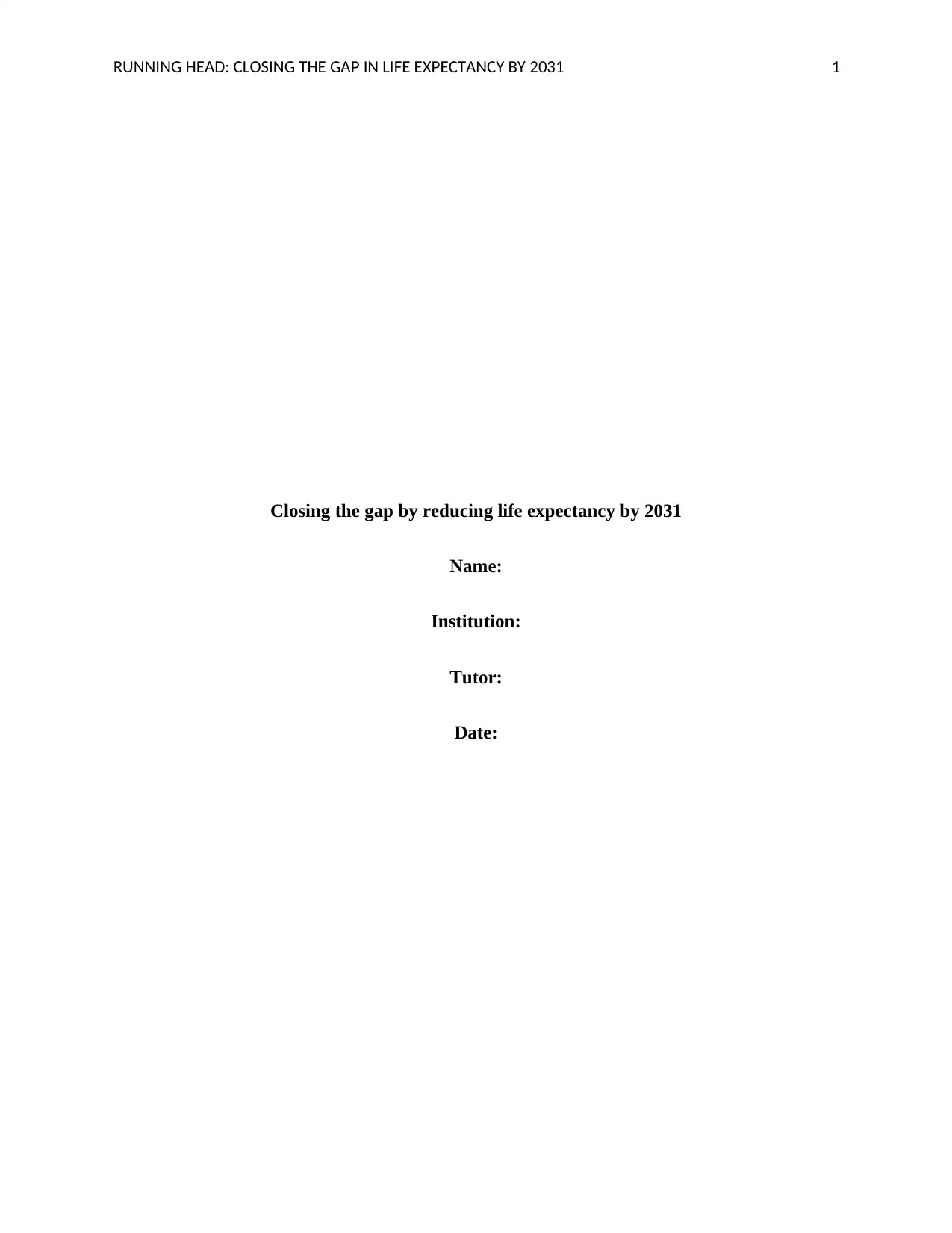
RUNNING HEAD: CLOSING THE GAP IN LIFE EXPECTANCY BY 2031 1
Closing the gap by reducing life expectancy by 2031
Name:
Institution:
Tutor:
Date:
Closing the gap by reducing life expectancy by 2031
Name:
Institution:
Tutor:
Date:
Secure Best Marks with AI Grader
Need help grading? Try our AI Grader for instant feedback on your assignments.
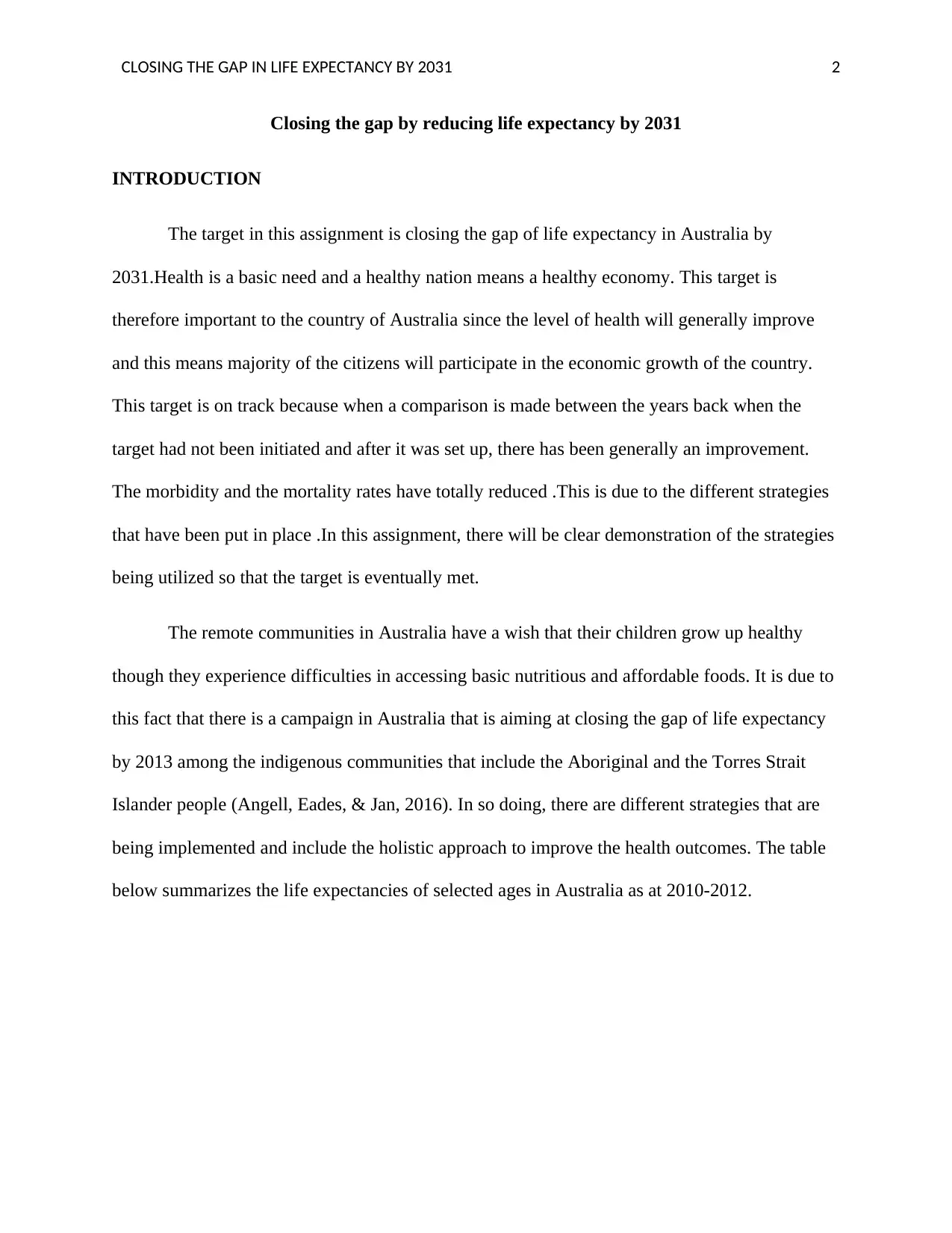
CLOSING THE GAP IN LIFE EXPECTANCY BY 2031 2
Closing the gap by reducing life expectancy by 2031
INTRODUCTION
The target in this assignment is closing the gap of life expectancy in Australia by
2031.Health is a basic need and a healthy nation means a healthy economy. This target is
therefore important to the country of Australia since the level of health will generally improve
and this means majority of the citizens will participate in the economic growth of the country.
This target is on track because when a comparison is made between the years back when the
target had not been initiated and after it was set up, there has been generally an improvement.
The morbidity and the mortality rates have totally reduced .This is due to the different strategies
that have been put in place .In this assignment, there will be clear demonstration of the strategies
being utilized so that the target is eventually met.
The remote communities in Australia have a wish that their children grow up healthy
though they experience difficulties in accessing basic nutritious and affordable foods. It is due to
this fact that there is a campaign in Australia that is aiming at closing the gap of life expectancy
by 2013 among the indigenous communities that include the Aboriginal and the Torres Strait
Islander people (Angell, Eades, & Jan, 2016). In so doing, there are different strategies that are
being implemented and include the holistic approach to improve the health outcomes. The table
below summarizes the life expectancies of selected ages in Australia as at 2010-2012.
Closing the gap by reducing life expectancy by 2031
INTRODUCTION
The target in this assignment is closing the gap of life expectancy in Australia by
2031.Health is a basic need and a healthy nation means a healthy economy. This target is
therefore important to the country of Australia since the level of health will generally improve
and this means majority of the citizens will participate in the economic growth of the country.
This target is on track because when a comparison is made between the years back when the
target had not been initiated and after it was set up, there has been generally an improvement.
The morbidity and the mortality rates have totally reduced .This is due to the different strategies
that have been put in place .In this assignment, there will be clear demonstration of the strategies
being utilized so that the target is eventually met.
The remote communities in Australia have a wish that their children grow up healthy
though they experience difficulties in accessing basic nutritious and affordable foods. It is due to
this fact that there is a campaign in Australia that is aiming at closing the gap of life expectancy
by 2013 among the indigenous communities that include the Aboriginal and the Torres Strait
Islander people (Angell, Eades, & Jan, 2016). In so doing, there are different strategies that are
being implemented and include the holistic approach to improve the health outcomes. The table
below summarizes the life expectancies of selected ages in Australia as at 2010-2012.
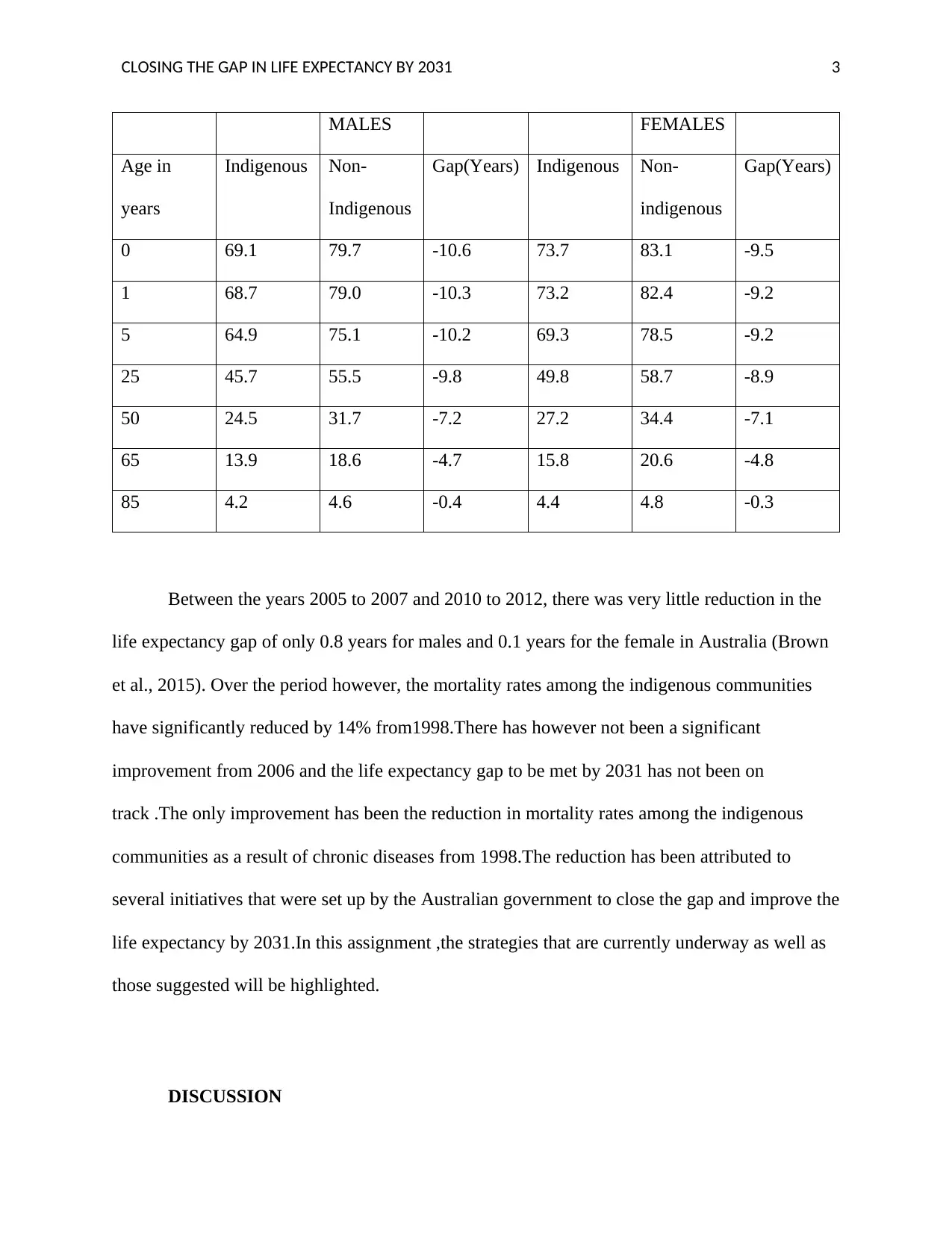
CLOSING THE GAP IN LIFE EXPECTANCY BY 2031 3
MALES FEMALES
Age in
years
Indigenous Non-
Indigenous
Gap(Years) Indigenous Non-
indigenous
Gap(Years)
0 69.1 79.7 -10.6 73.7 83.1 -9.5
1 68.7 79.0 -10.3 73.2 82.4 -9.2
5 64.9 75.1 -10.2 69.3 78.5 -9.2
25 45.7 55.5 -9.8 49.8 58.7 -8.9
50 24.5 31.7 -7.2 27.2 34.4 -7.1
65 13.9 18.6 -4.7 15.8 20.6 -4.8
85 4.2 4.6 -0.4 4.4 4.8 -0.3
Between the years 2005 to 2007 and 2010 to 2012, there was very little reduction in the
life expectancy gap of only 0.8 years for males and 0.1 years for the female in Australia (Brown
et al., 2015). Over the period however, the mortality rates among the indigenous communities
have significantly reduced by 14% from1998.There has however not been a significant
improvement from 2006 and the life expectancy gap to be met by 2031 has not been on
track .The only improvement has been the reduction in mortality rates among the indigenous
communities as a result of chronic diseases from 1998.The reduction has been attributed to
several initiatives that were set up by the Australian government to close the gap and improve the
life expectancy by 2031.In this assignment ,the strategies that are currently underway as well as
those suggested will be highlighted.
DISCUSSION
MALES FEMALES
Age in
years
Indigenous Non-
Indigenous
Gap(Years) Indigenous Non-
indigenous
Gap(Years)
0 69.1 79.7 -10.6 73.7 83.1 -9.5
1 68.7 79.0 -10.3 73.2 82.4 -9.2
5 64.9 75.1 -10.2 69.3 78.5 -9.2
25 45.7 55.5 -9.8 49.8 58.7 -8.9
50 24.5 31.7 -7.2 27.2 34.4 -7.1
65 13.9 18.6 -4.7 15.8 20.6 -4.8
85 4.2 4.6 -0.4 4.4 4.8 -0.3
Between the years 2005 to 2007 and 2010 to 2012, there was very little reduction in the
life expectancy gap of only 0.8 years for males and 0.1 years for the female in Australia (Brown
et al., 2015). Over the period however, the mortality rates among the indigenous communities
have significantly reduced by 14% from1998.There has however not been a significant
improvement from 2006 and the life expectancy gap to be met by 2031 has not been on
track .The only improvement has been the reduction in mortality rates among the indigenous
communities as a result of chronic diseases from 1998.The reduction has been attributed to
several initiatives that were set up by the Australian government to close the gap and improve the
life expectancy by 2031.In this assignment ,the strategies that are currently underway as well as
those suggested will be highlighted.
DISCUSSION
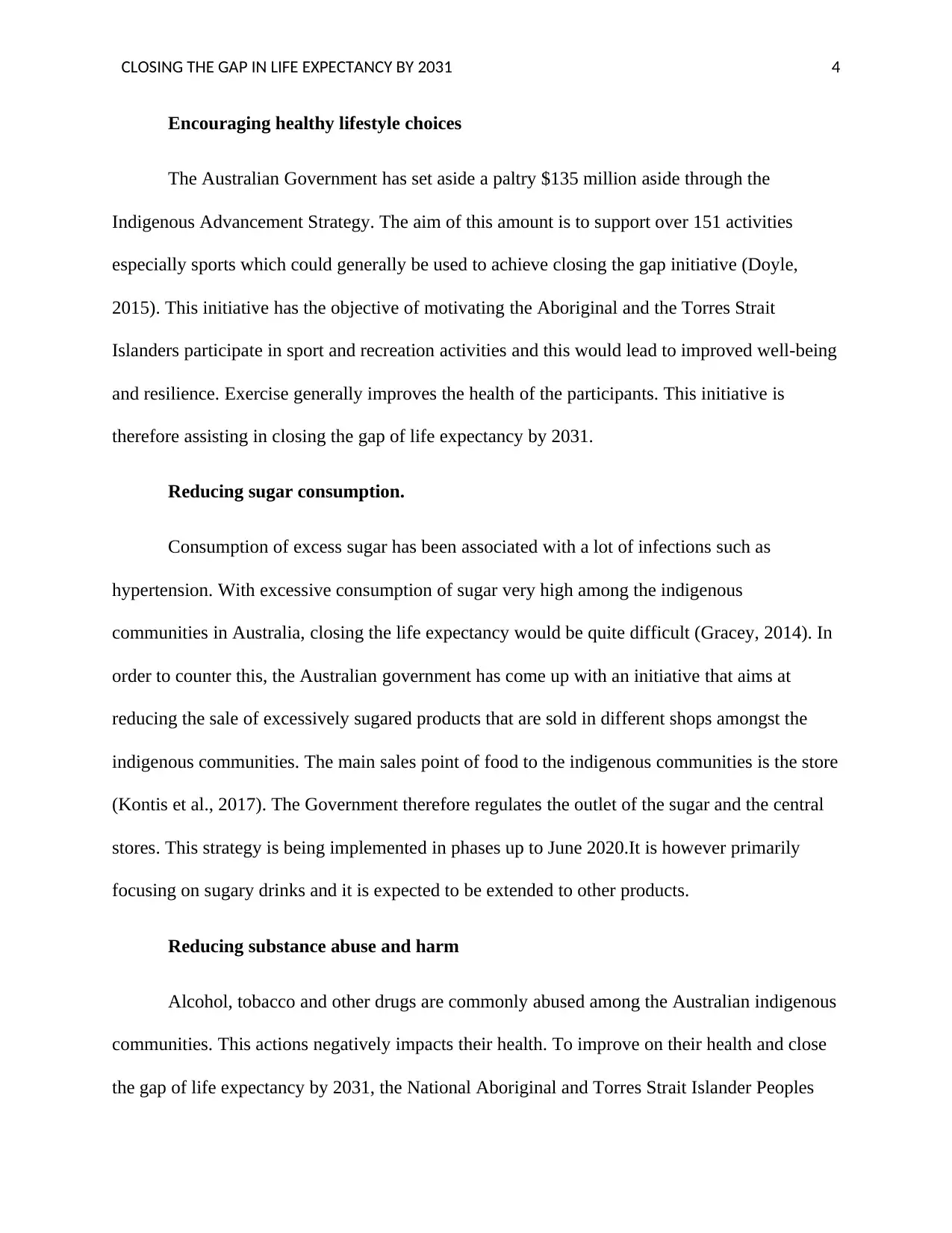
CLOSING THE GAP IN LIFE EXPECTANCY BY 2031 4
Encouraging healthy lifestyle choices
The Australian Government has set aside a paltry $135 million aside through the
Indigenous Advancement Strategy. The aim of this amount is to support over 151 activities
especially sports which could generally be used to achieve closing the gap initiative (Doyle,
2015). This initiative has the objective of motivating the Aboriginal and the Torres Strait
Islanders participate in sport and recreation activities and this would lead to improved well-being
and resilience. Exercise generally improves the health of the participants. This initiative is
therefore assisting in closing the gap of life expectancy by 2031.
Reducing sugar consumption.
Consumption of excess sugar has been associated with a lot of infections such as
hypertension. With excessive consumption of sugar very high among the indigenous
communities in Australia, closing the life expectancy would be quite difficult (Gracey, 2014). In
order to counter this, the Australian government has come up with an initiative that aims at
reducing the sale of excessively sugared products that are sold in different shops amongst the
indigenous communities. The main sales point of food to the indigenous communities is the store
(Kontis et al., 2017). The Government therefore regulates the outlet of the sugar and the central
stores. This strategy is being implemented in phases up to June 2020.It is however primarily
focusing on sugary drinks and it is expected to be extended to other products.
Reducing substance abuse and harm
Alcohol, tobacco and other drugs are commonly abused among the Australian indigenous
communities. This actions negatively impacts their health. To improve on their health and close
the gap of life expectancy by 2031, the National Aboriginal and Torres Strait Islander Peoples
Encouraging healthy lifestyle choices
The Australian Government has set aside a paltry $135 million aside through the
Indigenous Advancement Strategy. The aim of this amount is to support over 151 activities
especially sports which could generally be used to achieve closing the gap initiative (Doyle,
2015). This initiative has the objective of motivating the Aboriginal and the Torres Strait
Islanders participate in sport and recreation activities and this would lead to improved well-being
and resilience. Exercise generally improves the health of the participants. This initiative is
therefore assisting in closing the gap of life expectancy by 2031.
Reducing sugar consumption.
Consumption of excess sugar has been associated with a lot of infections such as
hypertension. With excessive consumption of sugar very high among the indigenous
communities in Australia, closing the life expectancy would be quite difficult (Gracey, 2014). In
order to counter this, the Australian government has come up with an initiative that aims at
reducing the sale of excessively sugared products that are sold in different shops amongst the
indigenous communities. The main sales point of food to the indigenous communities is the store
(Kontis et al., 2017). The Government therefore regulates the outlet of the sugar and the central
stores. This strategy is being implemented in phases up to June 2020.It is however primarily
focusing on sugary drinks and it is expected to be extended to other products.
Reducing substance abuse and harm
Alcohol, tobacco and other drugs are commonly abused among the Australian indigenous
communities. This actions negatively impacts their health. To improve on their health and close
the gap of life expectancy by 2031, the National Aboriginal and Torres Strait Islander Peoples
Secure Best Marks with AI Grader
Need help grading? Try our AI Grader for instant feedback on your assignments.
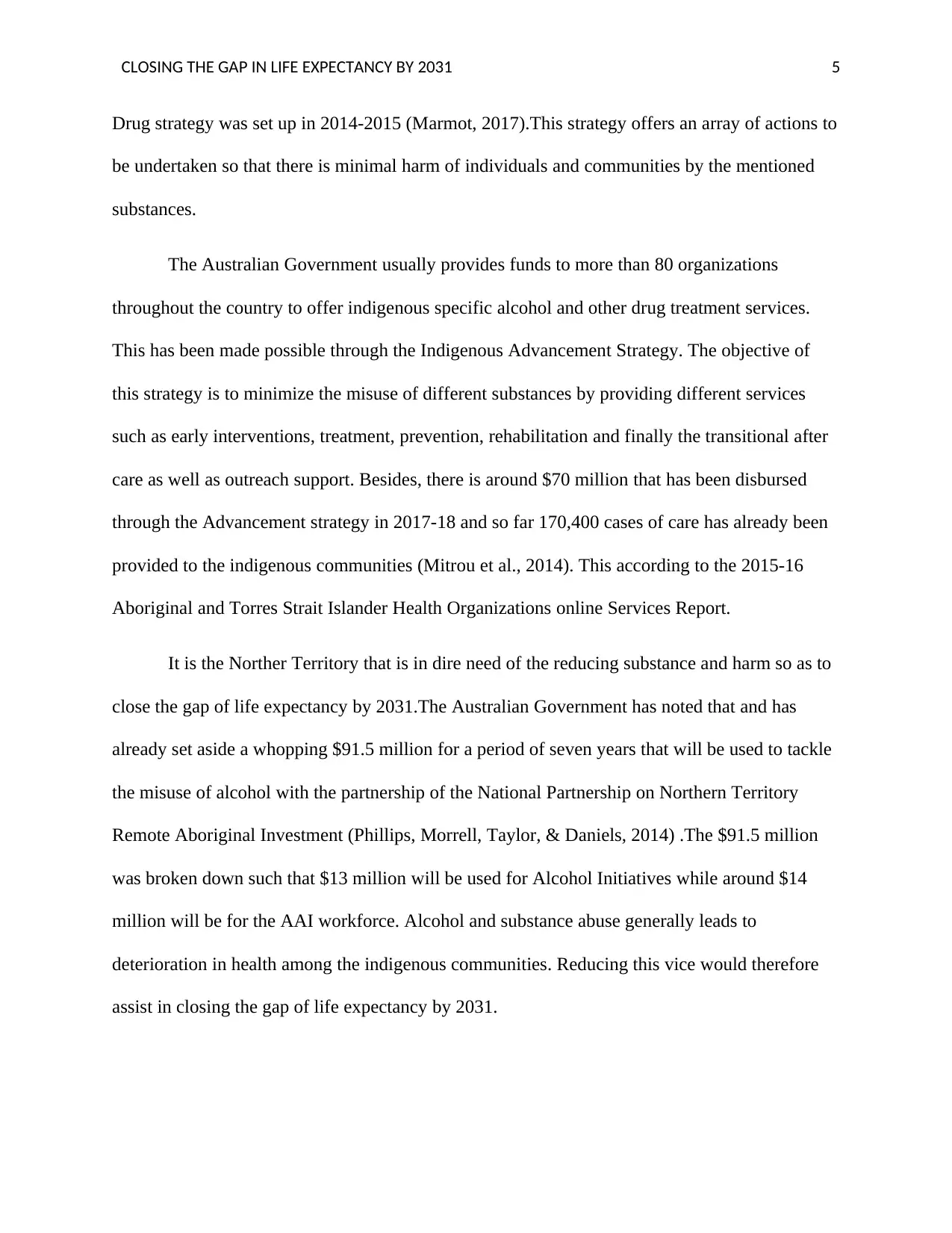
CLOSING THE GAP IN LIFE EXPECTANCY BY 2031 5
Drug strategy was set up in 2014-2015 (Marmot, 2017).This strategy offers an array of actions to
be undertaken so that there is minimal harm of individuals and communities by the mentioned
substances.
The Australian Government usually provides funds to more than 80 organizations
throughout the country to offer indigenous specific alcohol and other drug treatment services.
This has been made possible through the Indigenous Advancement Strategy. The objective of
this strategy is to minimize the misuse of different substances by providing different services
such as early interventions, treatment, prevention, rehabilitation and finally the transitional after
care as well as outreach support. Besides, there is around $70 million that has been disbursed
through the Advancement strategy in 2017-18 and so far 170,400 cases of care has already been
provided to the indigenous communities (Mitrou et al., 2014). This according to the 2015-16
Aboriginal and Torres Strait Islander Health Organizations online Services Report.
It is the Norther Territory that is in dire need of the reducing substance and harm so as to
close the gap of life expectancy by 2031.The Australian Government has noted that and has
already set aside a whopping $91.5 million for a period of seven years that will be used to tackle
the misuse of alcohol with the partnership of the National Partnership on Northern Territory
Remote Aboriginal Investment (Phillips, Morrell, Taylor, & Daniels, 2014) .The $91.5 million
was broken down such that $13 million will be used for Alcohol Initiatives while around $14
million will be for the AAI workforce. Alcohol and substance abuse generally leads to
deterioration in health among the indigenous communities. Reducing this vice would therefore
assist in closing the gap of life expectancy by 2031.
Drug strategy was set up in 2014-2015 (Marmot, 2017).This strategy offers an array of actions to
be undertaken so that there is minimal harm of individuals and communities by the mentioned
substances.
The Australian Government usually provides funds to more than 80 organizations
throughout the country to offer indigenous specific alcohol and other drug treatment services.
This has been made possible through the Indigenous Advancement Strategy. The objective of
this strategy is to minimize the misuse of different substances by providing different services
such as early interventions, treatment, prevention, rehabilitation and finally the transitional after
care as well as outreach support. Besides, there is around $70 million that has been disbursed
through the Advancement strategy in 2017-18 and so far 170,400 cases of care has already been
provided to the indigenous communities (Mitrou et al., 2014). This according to the 2015-16
Aboriginal and Torres Strait Islander Health Organizations online Services Report.
It is the Norther Territory that is in dire need of the reducing substance and harm so as to
close the gap of life expectancy by 2031.The Australian Government has noted that and has
already set aside a whopping $91.5 million for a period of seven years that will be used to tackle
the misuse of alcohol with the partnership of the National Partnership on Northern Territory
Remote Aboriginal Investment (Phillips, Morrell, Taylor, & Daniels, 2014) .The $91.5 million
was broken down such that $13 million will be used for Alcohol Initiatives while around $14
million will be for the AAI workforce. Alcohol and substance abuse generally leads to
deterioration in health among the indigenous communities. Reducing this vice would therefore
assist in closing the gap of life expectancy by 2031.
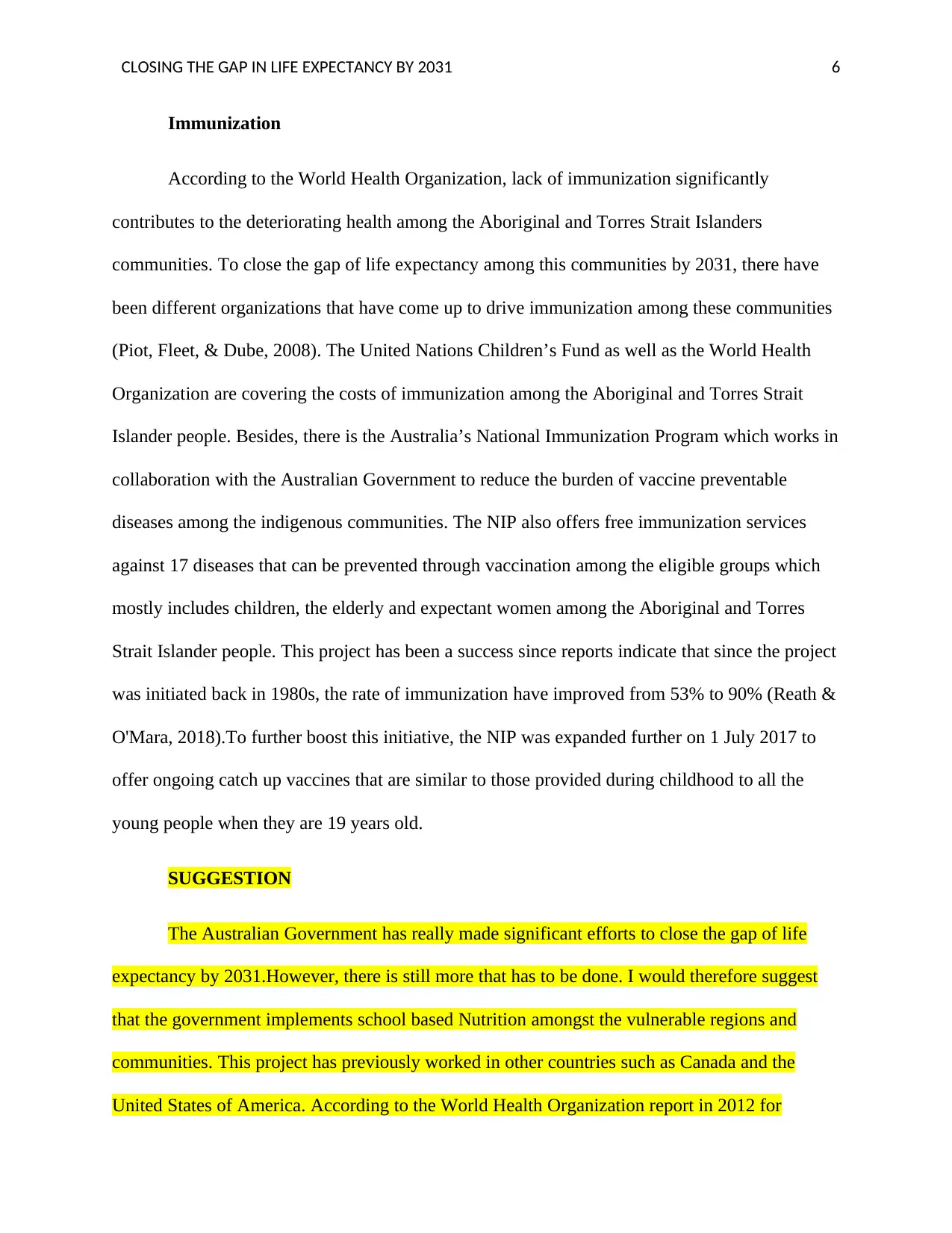
CLOSING THE GAP IN LIFE EXPECTANCY BY 2031 6
Immunization
According to the World Health Organization, lack of immunization significantly
contributes to the deteriorating health among the Aboriginal and Torres Strait Islanders
communities. To close the gap of life expectancy among this communities by 2031, there have
been different organizations that have come up to drive immunization among these communities
(Piot, Fleet, & Dube, 2008). The United Nations Children’s Fund as well as the World Health
Organization are covering the costs of immunization among the Aboriginal and Torres Strait
Islander people. Besides, there is the Australia’s National Immunization Program which works in
collaboration with the Australian Government to reduce the burden of vaccine preventable
diseases among the indigenous communities. The NIP also offers free immunization services
against 17 diseases that can be prevented through vaccination among the eligible groups which
mostly includes children, the elderly and expectant women among the Aboriginal and Torres
Strait Islander people. This project has been a success since reports indicate that since the project
was initiated back in 1980s, the rate of immunization have improved from 53% to 90% (Reath &
O'Mara, 2018).To further boost this initiative, the NIP was expanded further on 1 July 2017 to
offer ongoing catch up vaccines that are similar to those provided during childhood to all the
young people when they are 19 years old.
SUGGESTION
The Australian Government has really made significant efforts to close the gap of life
expectancy by 2031.However, there is still more that has to be done. I would therefore suggest
that the government implements school based Nutrition amongst the vulnerable regions and
communities. This project has previously worked in other countries such as Canada and the
United States of America. According to the World Health Organization report in 2012 for
Immunization
According to the World Health Organization, lack of immunization significantly
contributes to the deteriorating health among the Aboriginal and Torres Strait Islanders
communities. To close the gap of life expectancy among this communities by 2031, there have
been different organizations that have come up to drive immunization among these communities
(Piot, Fleet, & Dube, 2008). The United Nations Children’s Fund as well as the World Health
Organization are covering the costs of immunization among the Aboriginal and Torres Strait
Islander people. Besides, there is the Australia’s National Immunization Program which works in
collaboration with the Australian Government to reduce the burden of vaccine preventable
diseases among the indigenous communities. The NIP also offers free immunization services
against 17 diseases that can be prevented through vaccination among the eligible groups which
mostly includes children, the elderly and expectant women among the Aboriginal and Torres
Strait Islander people. This project has been a success since reports indicate that since the project
was initiated back in 1980s, the rate of immunization have improved from 53% to 90% (Reath &
O'Mara, 2018).To further boost this initiative, the NIP was expanded further on 1 July 2017 to
offer ongoing catch up vaccines that are similar to those provided during childhood to all the
young people when they are 19 years old.
SUGGESTION
The Australian Government has really made significant efforts to close the gap of life
expectancy by 2031.However, there is still more that has to be done. I would therefore suggest
that the government implements school based Nutrition amongst the vulnerable regions and
communities. This project has previously worked in other countries such as Canada and the
United States of America. According to the World Health Organization report in 2012 for
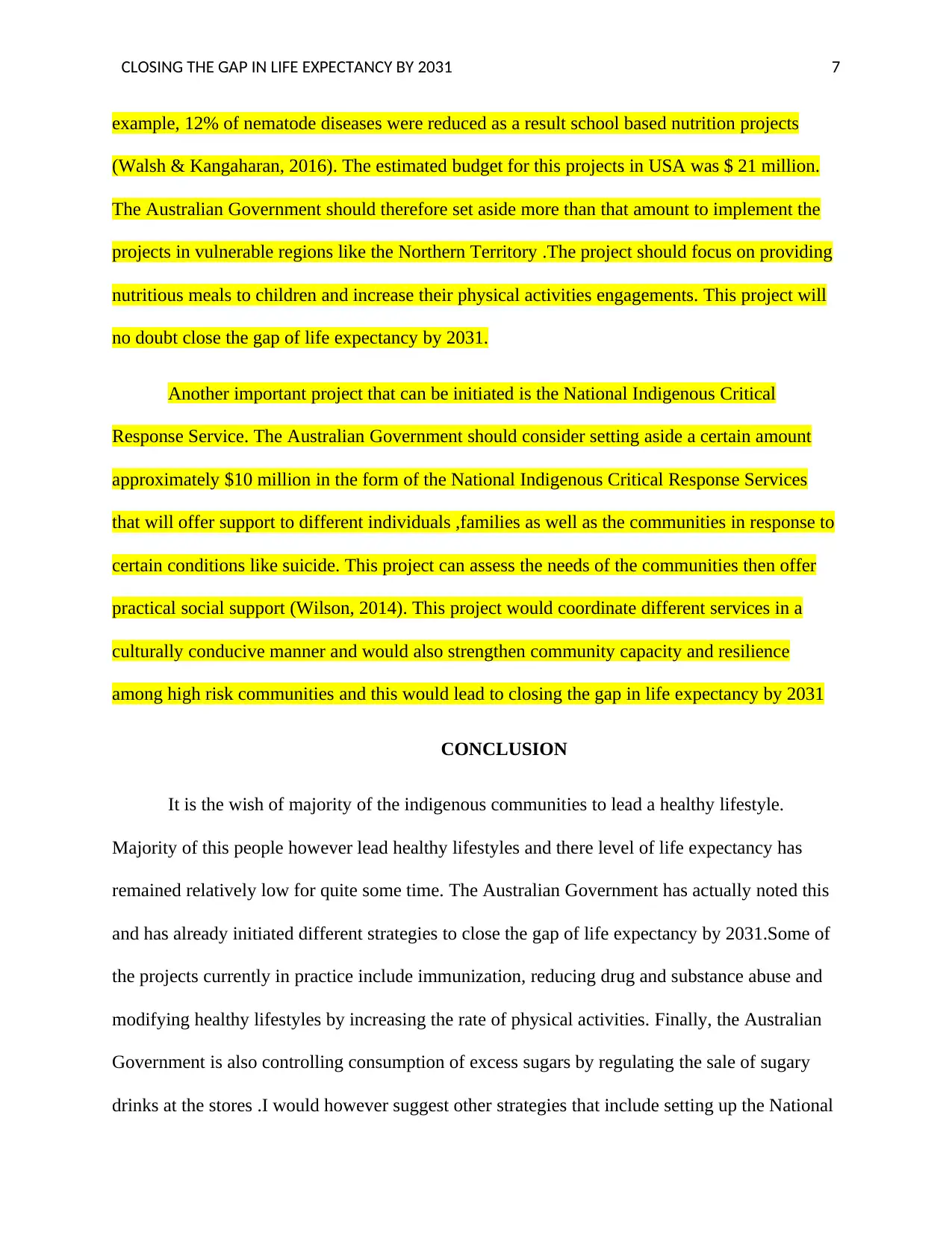
CLOSING THE GAP IN LIFE EXPECTANCY BY 2031 7
example, 12% of nematode diseases were reduced as a result school based nutrition projects
(Walsh & Kangaharan, 2016). The estimated budget for this projects in USA was $ 21 million.
The Australian Government should therefore set aside more than that amount to implement the
projects in vulnerable regions like the Northern Territory .The project should focus on providing
nutritious meals to children and increase their physical activities engagements. This project will
no doubt close the gap of life expectancy by 2031.
Another important project that can be initiated is the National Indigenous Critical
Response Service. The Australian Government should consider setting aside a certain amount
approximately $10 million in the form of the National Indigenous Critical Response Services
that will offer support to different individuals ,families as well as the communities in response to
certain conditions like suicide. This project can assess the needs of the communities then offer
practical social support (Wilson, 2014). This project would coordinate different services in a
culturally conducive manner and would also strengthen community capacity and resilience
among high risk communities and this would lead to closing the gap in life expectancy by 2031
CONCLUSION
It is the wish of majority of the indigenous communities to lead a healthy lifestyle.
Majority of this people however lead healthy lifestyles and there level of life expectancy has
remained relatively low for quite some time. The Australian Government has actually noted this
and has already initiated different strategies to close the gap of life expectancy by 2031.Some of
the projects currently in practice include immunization, reducing drug and substance abuse and
modifying healthy lifestyles by increasing the rate of physical activities. Finally, the Australian
Government is also controlling consumption of excess sugars by regulating the sale of sugary
drinks at the stores .I would however suggest other strategies that include setting up the National
example, 12% of nematode diseases were reduced as a result school based nutrition projects
(Walsh & Kangaharan, 2016). The estimated budget for this projects in USA was $ 21 million.
The Australian Government should therefore set aside more than that amount to implement the
projects in vulnerable regions like the Northern Territory .The project should focus on providing
nutritious meals to children and increase their physical activities engagements. This project will
no doubt close the gap of life expectancy by 2031.
Another important project that can be initiated is the National Indigenous Critical
Response Service. The Australian Government should consider setting aside a certain amount
approximately $10 million in the form of the National Indigenous Critical Response Services
that will offer support to different individuals ,families as well as the communities in response to
certain conditions like suicide. This project can assess the needs of the communities then offer
practical social support (Wilson, 2014). This project would coordinate different services in a
culturally conducive manner and would also strengthen community capacity and resilience
among high risk communities and this would lead to closing the gap in life expectancy by 2031
CONCLUSION
It is the wish of majority of the indigenous communities to lead a healthy lifestyle.
Majority of this people however lead healthy lifestyles and there level of life expectancy has
remained relatively low for quite some time. The Australian Government has actually noted this
and has already initiated different strategies to close the gap of life expectancy by 2031.Some of
the projects currently in practice include immunization, reducing drug and substance abuse and
modifying healthy lifestyles by increasing the rate of physical activities. Finally, the Australian
Government is also controlling consumption of excess sugars by regulating the sale of sugary
drinks at the stores .I would however suggest other strategies that include setting up the National
Paraphrase This Document
Need a fresh take? Get an instant paraphrase of this document with our AI Paraphraser
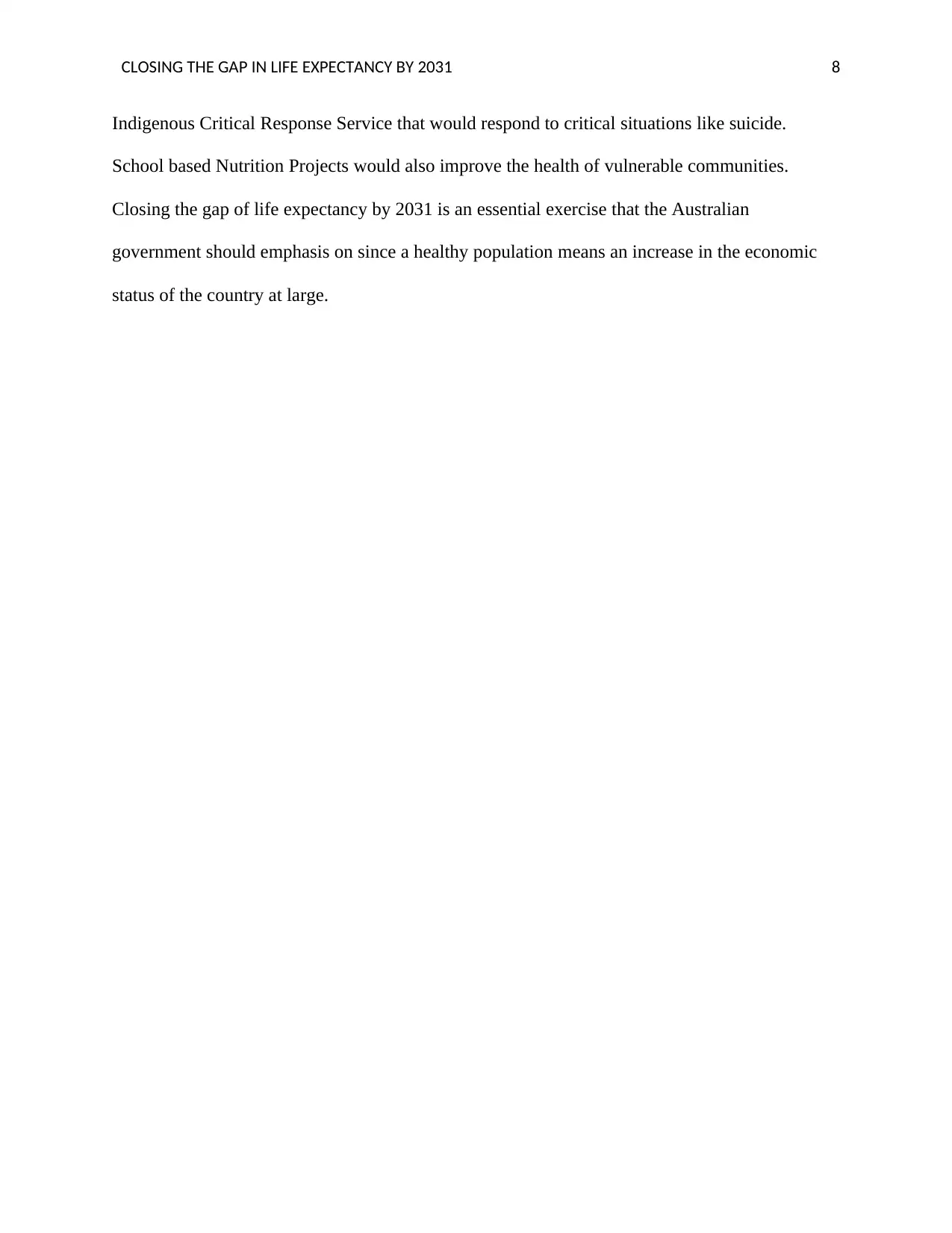
CLOSING THE GAP IN LIFE EXPECTANCY BY 2031 8
Indigenous Critical Response Service that would respond to critical situations like suicide.
School based Nutrition Projects would also improve the health of vulnerable communities.
Closing the gap of life expectancy by 2031 is an essential exercise that the Australian
government should emphasis on since a healthy population means an increase in the economic
status of the country at large.
Indigenous Critical Response Service that would respond to critical situations like suicide.
School based Nutrition Projects would also improve the health of vulnerable communities.
Closing the gap of life expectancy by 2031 is an essential exercise that the Australian
government should emphasis on since a healthy population means an increase in the economic
status of the country at large.
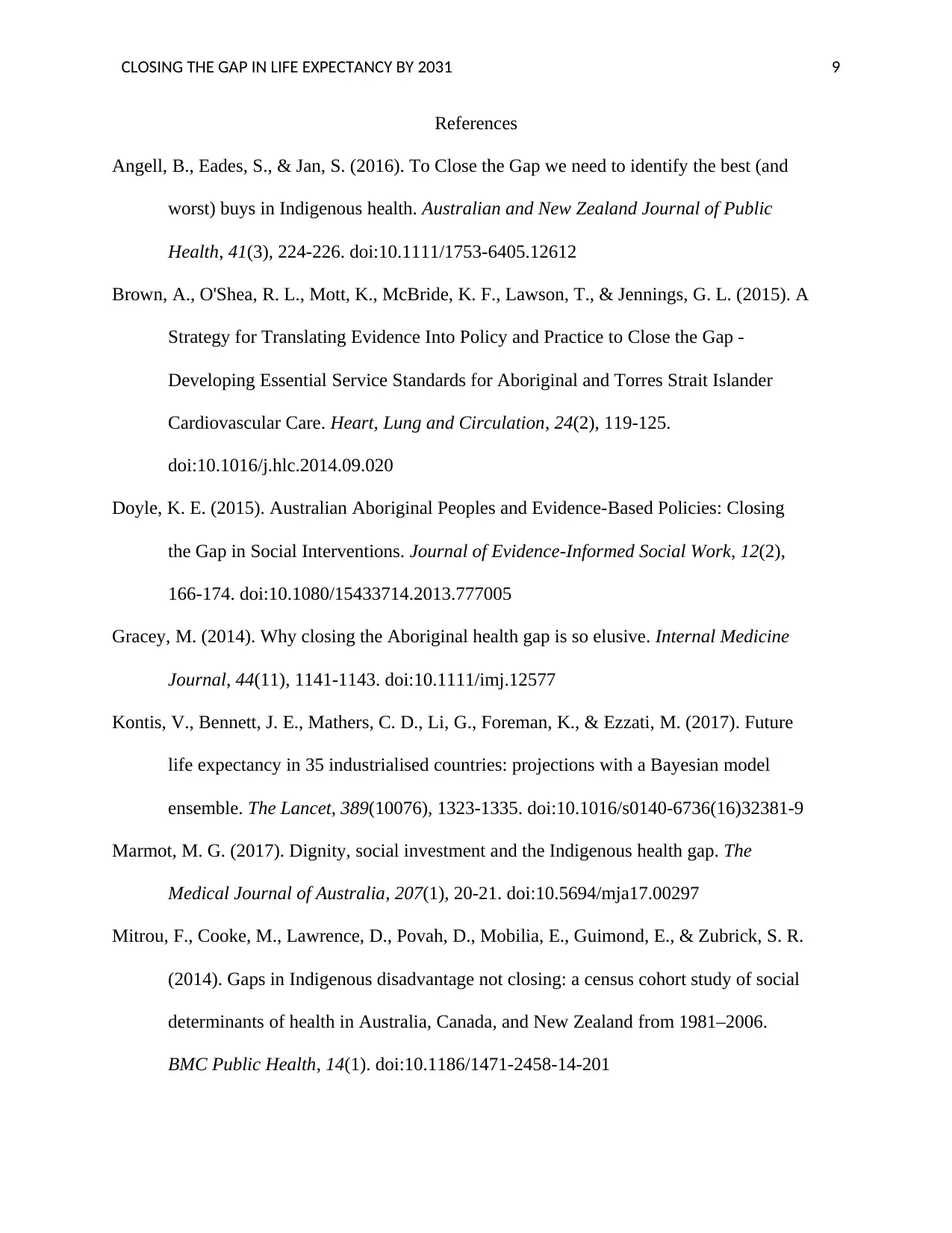
CLOSING THE GAP IN LIFE EXPECTANCY BY 2031 9
References
Angell, B., Eades, S., & Jan, S. (2016). To Close the Gap we need to identify the best (and
worst) buys in Indigenous health. Australian and New Zealand Journal of Public
Health, 41(3), 224-226. doi:10.1111/1753-6405.12612
Brown, A., O'Shea, R. L., Mott, K., McBride, K. F., Lawson, T., & Jennings, G. L. (2015). A
Strategy for Translating Evidence Into Policy and Practice to Close the Gap -
Developing Essential Service Standards for Aboriginal and Torres Strait Islander
Cardiovascular Care. Heart, Lung and Circulation, 24(2), 119-125.
doi:10.1016/j.hlc.2014.09.020
Doyle, K. E. (2015). Australian Aboriginal Peoples and Evidence-Based Policies: Closing
the Gap in Social Interventions. Journal of Evidence-Informed Social Work, 12(2),
166-174. doi:10.1080/15433714.2013.777005
Gracey, M. (2014). Why closing the Aboriginal health gap is so elusive. Internal Medicine
Journal, 44(11), 1141-1143. doi:10.1111/imj.12577
Kontis, V., Bennett, J. E., Mathers, C. D., Li, G., Foreman, K., & Ezzati, M. (2017). Future
life expectancy in 35 industrialised countries: projections with a Bayesian model
ensemble. The Lancet, 389(10076), 1323-1335. doi:10.1016/s0140-6736(16)32381-9
Marmot, M. G. (2017). Dignity, social investment and the Indigenous health gap. The
Medical Journal of Australia, 207(1), 20-21. doi:10.5694/mja17.00297
Mitrou, F., Cooke, M., Lawrence, D., Povah, D., Mobilia, E., Guimond, E., & Zubrick, S. R.
(2014). Gaps in Indigenous disadvantage not closing: a census cohort study of social
determinants of health in Australia, Canada, and New Zealand from 1981–2006.
BMC Public Health, 14(1). doi:10.1186/1471-2458-14-201
References
Angell, B., Eades, S., & Jan, S. (2016). To Close the Gap we need to identify the best (and
worst) buys in Indigenous health. Australian and New Zealand Journal of Public
Health, 41(3), 224-226. doi:10.1111/1753-6405.12612
Brown, A., O'Shea, R. L., Mott, K., McBride, K. F., Lawson, T., & Jennings, G. L. (2015). A
Strategy for Translating Evidence Into Policy and Practice to Close the Gap -
Developing Essential Service Standards for Aboriginal and Torres Strait Islander
Cardiovascular Care. Heart, Lung and Circulation, 24(2), 119-125.
doi:10.1016/j.hlc.2014.09.020
Doyle, K. E. (2015). Australian Aboriginal Peoples and Evidence-Based Policies: Closing
the Gap in Social Interventions. Journal of Evidence-Informed Social Work, 12(2),
166-174. doi:10.1080/15433714.2013.777005
Gracey, M. (2014). Why closing the Aboriginal health gap is so elusive. Internal Medicine
Journal, 44(11), 1141-1143. doi:10.1111/imj.12577
Kontis, V., Bennett, J. E., Mathers, C. D., Li, G., Foreman, K., & Ezzati, M. (2017). Future
life expectancy in 35 industrialised countries: projections with a Bayesian model
ensemble. The Lancet, 389(10076), 1323-1335. doi:10.1016/s0140-6736(16)32381-9
Marmot, M. G. (2017). Dignity, social investment and the Indigenous health gap. The
Medical Journal of Australia, 207(1), 20-21. doi:10.5694/mja17.00297
Mitrou, F., Cooke, M., Lawrence, D., Povah, D., Mobilia, E., Guimond, E., & Zubrick, S. R.
(2014). Gaps in Indigenous disadvantage not closing: a census cohort study of social
determinants of health in Australia, Canada, and New Zealand from 1981–2006.
BMC Public Health, 14(1). doi:10.1186/1471-2458-14-201
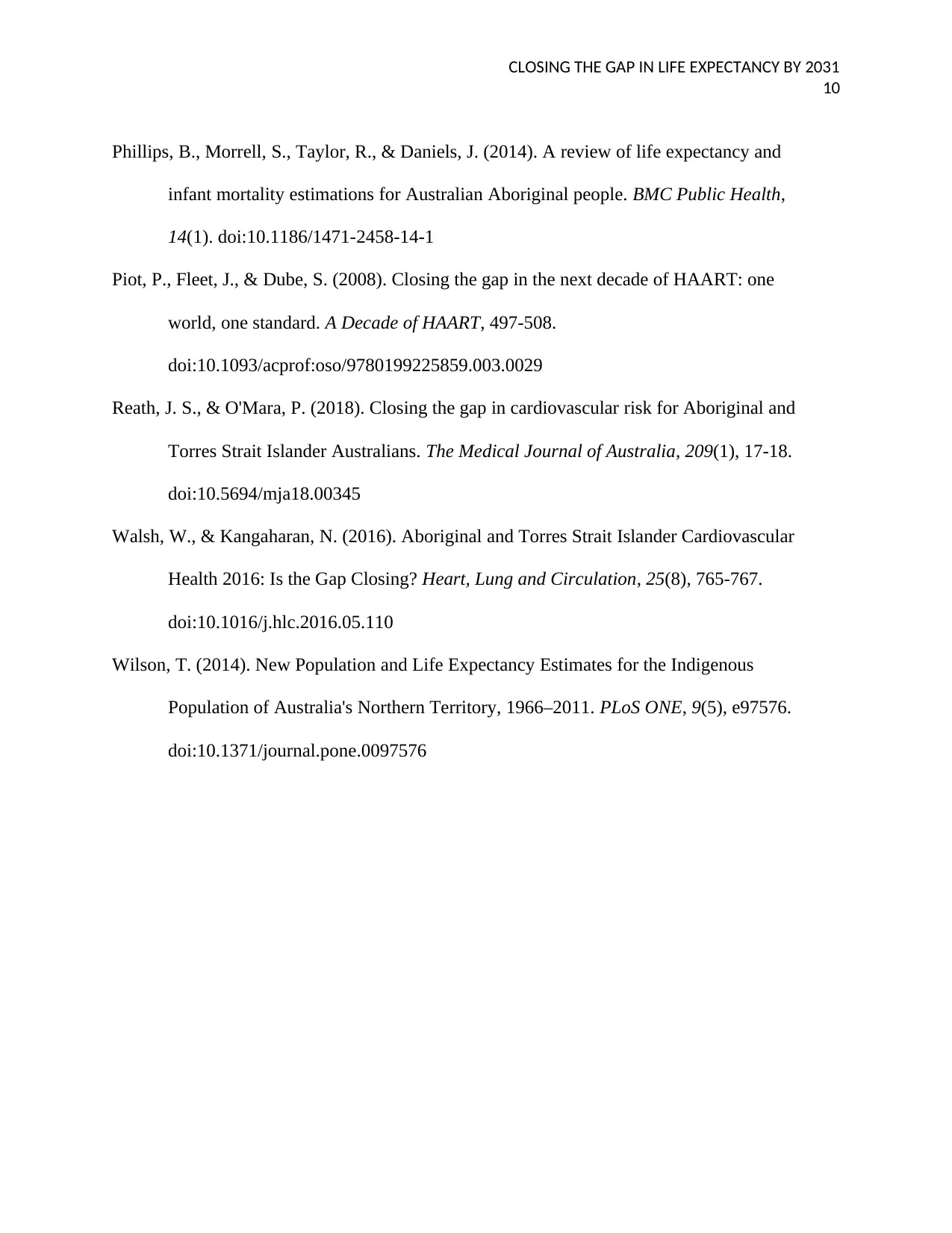
CLOSING THE GAP IN LIFE EXPECTANCY BY 2031
10
Phillips, B., Morrell, S., Taylor, R., & Daniels, J. (2014). A review of life expectancy and
infant mortality estimations for Australian Aboriginal people. BMC Public Health,
14(1). doi:10.1186/1471-2458-14-1
Piot, P., Fleet, J., & Dube, S. (2008). Closing the gap in the next decade of HAART: one
world, one standard. A Decade of HAART, 497-508.
doi:10.1093/acprof:oso/9780199225859.003.0029
Reath, J. S., & O'Mara, P. (2018). Closing the gap in cardiovascular risk for Aboriginal and
Torres Strait Islander Australians. The Medical Journal of Australia, 209(1), 17-18.
doi:10.5694/mja18.00345
Walsh, W., & Kangaharan, N. (2016). Aboriginal and Torres Strait Islander Cardiovascular
Health 2016: Is the Gap Closing? Heart, Lung and Circulation, 25(8), 765-767.
doi:10.1016/j.hlc.2016.05.110
Wilson, T. (2014). New Population and Life Expectancy Estimates for the Indigenous
Population of Australia's Northern Territory, 1966–2011. PLoS ONE, 9(5), e97576.
doi:10.1371/journal.pone.0097576
10
Phillips, B., Morrell, S., Taylor, R., & Daniels, J. (2014). A review of life expectancy and
infant mortality estimations for Australian Aboriginal people. BMC Public Health,
14(1). doi:10.1186/1471-2458-14-1
Piot, P., Fleet, J., & Dube, S. (2008). Closing the gap in the next decade of HAART: one
world, one standard. A Decade of HAART, 497-508.
doi:10.1093/acprof:oso/9780199225859.003.0029
Reath, J. S., & O'Mara, P. (2018). Closing the gap in cardiovascular risk for Aboriginal and
Torres Strait Islander Australians. The Medical Journal of Australia, 209(1), 17-18.
doi:10.5694/mja18.00345
Walsh, W., & Kangaharan, N. (2016). Aboriginal and Torres Strait Islander Cardiovascular
Health 2016: Is the Gap Closing? Heart, Lung and Circulation, 25(8), 765-767.
doi:10.1016/j.hlc.2016.05.110
Wilson, T. (2014). New Population and Life Expectancy Estimates for the Indigenous
Population of Australia's Northern Territory, 1966–2011. PLoS ONE, 9(5), e97576.
doi:10.1371/journal.pone.0097576
1 out of 10
Related Documents
Your All-in-One AI-Powered Toolkit for Academic Success.
+13062052269
info@desklib.com
Available 24*7 on WhatsApp / Email
![[object Object]](/_next/static/media/star-bottom.7253800d.svg)
Unlock your academic potential
© 2024 | Zucol Services PVT LTD | All rights reserved.




